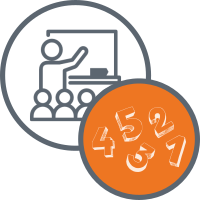You are here
Effective Mathematics Teaching Practice 4: Facilitate Meaningful Mathematical Discourse
Instructional Support Menu
Facilitate Meaningful Mathematical Discourse
NCTM’s effective mathematics teaching practice facilitate meaningful mathematical discourse has come to be seen as somewhat of a “meta-practice” that includes several others, such as pose purposeful questions, use and connect mathematical representations, and elicit and use evidence of student thinking. All of these practices come together to shape the way thinking is supported and communicated in a mathematics classroom.
The most widely used guide for facilitating discourse in mathematics classrooms is 5 Practices for Orchestrating Productive Mathematics Discussions by Margaret Smith and Mary Kay Stein. (Yes, this gets a bit confusing, as this one NCTM effective teaching practice leans heavily on the work of a book called 5 Practices, which maybe is better thought of as an instructional model for teaching a lesson.) The five practices are (pp 9-10):
- Anticipating likely student responses to challenging mathematical tasks and questions to ask to students to produce them;
- Monitoring students’ actual responses to the tasks (while students work on the tasks in pairs or small groups);
- Selecting particular students to present their mathematical work during the whole-class discussion;
- Sequencing the student responses that will be displayed in a specific order; and
- Connecting different students’ responses and connecting the responses to key mathematical ideas.
Whether or not a teacher is following the 5 Practices instructional model or not, the goal is to shift teaching away from the teacher being the dominant speaker and information authority and to build a shared culture where students lead conversations themselves and the teacher is there to probe into thinking more deeply, connect students' ideas, and sharpen the students' collective understanding.
Effective teaching of mathematics facilitates discourse among students to build shared understanding of mathematical ideas by analyzing and comparing student approaches and arguments.
-NCTM (2014), p. 29
The Practice in Action
One of the ways NCTM (2014, p. 35) summarizes the practice of facilitate meaningful mathematical discourse is by describing a set of actions expected of teachers and students that indicate engagement in this teaching practice.
Caution! Don't over-estimate your own understanding based on these brief descriptions of teaching practice. Professional educators should dig more deeply into NCTM's resources, join study groups and professional networks, and seek out professional development and coaching to ensure high-quality engagement in the practice.
What are teachers doing?
- Engaging students in purposeful sharing of mathematical ideas, reasoning, and approaches, using varied representations.
- Selecting and sequencing student approaches and solution strategies for whole-class analysis and discussion.
- Facilitating discourse among students by positioning them as authors of ideas, who explain and defend their approaches.
- Ensuring progress toward mathematical goals by making explicit connections to student approaches and reasoning.
What are students doing?
- Presenting and explaining ideas, reasoning, and representations to one another in pair, small-group, and whole-class discourse.
- Listening carefully to and critiquing the reasoning of peers, using examples to support or counterexamples to refute arguments.
- Seeking to understand the approaches used by peers by asking clarifying questions, trying out others’ strategies, and describing the approaches used by others.
- Identifying how different approaches to solving a task are the same and how they are different.
Resources
- Principles to Action: Ensuring Mathematical Success for All (NCTM, 2014, pp. 29-35)
- Taking Action: Implementing Effective Mathematics Teaching Practices in K-Grade 5 (NCTM, 2017, pp. 145-179)
- Taking Action: Implementing Effective Mathematics Teaching Practices in Grades 6-8 (NCTM, 2017, pp. 123-142)
- Taking Action: Implementing Effective Mathematics Teaching Practices in Grades 9-12 (NCTM, 2017, pp. 125-148)
- Enhancing Classroom Practice with Research behind Principles to Actions (NCTM, 2017, pp. 37-48)
- 5 Practices for Orchestrating Productive Mathematical Discussion, 2nd Ed. (Smith & Stein, 2018)




Connect With Us




